Apple Chutney & Mango Chutney
सेब की चटनी & आम की चटनी
ਸੇਬ ਦੀ ਚਟਨੀ & ਅੰਬ ਦੀ ਚਟਨੀ
Two simple, very easy to produce, clean-tasting chutneys.
In the UK, you can buy stuff that is sold as chutney but these are often pickles or relishes - 'chutney', 'pickle' and 'relish' being used in modern English without regard for the meaning of the words. It is better if you can make your own fresh, real chutneys - they taste better and you know what is in them.
 | Hand blender - useful for small
quantities such as fresh chutney. |
'Chutney' (चटनी - ਚਟਨੀ) is Hindi for 'sauce' and these usually take two contrasting flavour types and put them together - often with something to assist with digestion.
As with many recipes, the number of ingredients you use in any given chutney will dictate how 'pure' or 'clean' the flavour is - if you want a mango chutney but then go and put ten different spices in it, it isn't going to taste much like mango when you have finished.
Flavours are like colours - if you mix a lot of different ones together, you end up with a dirty grey. Keeping to just a few flavours makes 'clean-tasting' food with an identifiable flavour that you can enjoy for what it is.
The main part of a meal has in it whatever you design but a sauce adds a particular flavour that should not confuse the flavours that are already in the main meal - you should not have in the chutney a substantial quantitiy of a flavour that is in the main meal - the chutney should add to, not confuse the flavours in the meal.
One advantage that making your own, fresh chutneys is that you don't have to add anything that's role is a preservative - unless it modifies the flavour of something in a particular way that you want - lemon juice modifying onion for example. This gives you the advantage of keeping it simple and clean-tasting.
The two chutneys below are basic, use commonly available ingredients and will go with most meals.
They use a base of raw, red onion (savoury) which takes around 40 per cent of the chutney with the fruit (sweet) part of the chutney, taking around 60 per cent. In both cases, acids in the fruit reduce the activity of the onion and mint helps digestion.
The onion used in this is raw - there is no cooking in the case of these chutneys - and that has quite a different flavour to the fried onion that you will have in the main part of the meal that you are using the chutneys with.
So, you have: - only a few ingredients;
- contrasting flavours; and,
- no interference with flavours that are in the main meal.
and, they are extremely easy and quick to make.
Apple Chutney
Ingredients:
- 150g Apple - pealed, cored
- 100g red onion
- handful of washed, fresh English garden mint leaves (spear mint)
Method:
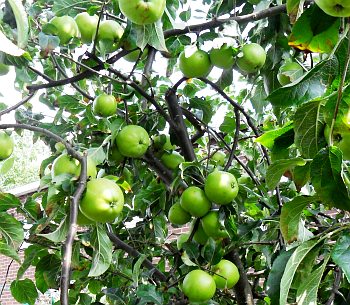 | If you have your own apple tree, you will end
up with too many for the tree to support. |
If you are lucky enough to have your own apple tree, you will end up, some years, where you have too much fruit on it to make it through all of the summer to the time that they should be picked.
These immature apples are usually not that sweet but they are still apples and taste like it as well.
Windfall apples are also potential fruit for making chutney from.
If you haven't got access to either, you can buy some cooking apples in the shop or, if you find that a little tart, some sweeter varieties.
The main requirement for the apples is that they have some acid in them so that the onion that you are going to use will have some of the edge taken off naturally by this.
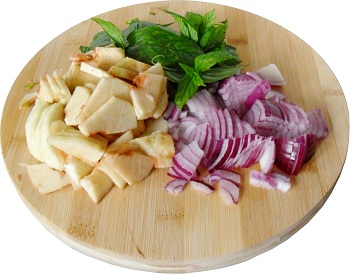 | Apple, mint and red onion.
Ready to blend. |
So, core and skin the apples, top and tail the onion and wash the mint.
You don't need to chop up anything particularly finely because you are going to blend it all together.
However, the bits that you do use need to be accessible to the blades of the blender so make sure that there is nothing in there that is more than around a 2cm cube.
Put around half of the apple and onion in the plastic jug, then the mint leaves and then the rest of the apple and onion.
Doing this will make sure that the blades are wet before they get to the leaves which are flat and might tend to lay flat on the surface of the blender instead of being chopped up.
Also, by doing that, the leaves are not on the bottom of the container where they would tend to stick flat as well, with the same consequence.
Blend the contents of the jug, pushing the hand blender end down into the mixture a bit at a time until it is all done. You can tilt the blender so that it generates a flow that will make it easier but you will find that if air gets into the cavity where the blades are, it will speed up and no blending will be done. When that happens, just switch it off and push it further into the chutney then start it again.
Soon, you will have a nice chutney, looking like the picture below.
Taste it and if you find that there is too much onion there, you can add more apple, or, if you like, you can add some lemon juice to take the edge off the onion. You can also add a little sugar to take the edge off the lemon juice.
You can add anything you want but remember that simple tastes best.
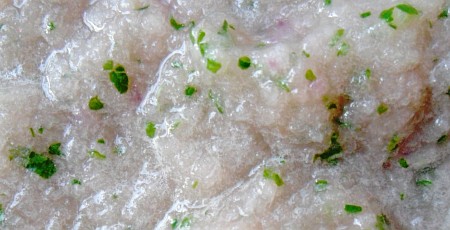 | Apple chutney, ready for dipping.
Samosas, pakoras, parathas... |
Variations:
Add anything that you like:
- Add some lemon juice to take the edge off the onion
- Add some sugar /jaggery to take the edge off the lemon juice or apple if they are particularly sour
- Add a few drops of pomegranate molasses to take the flavour in a slightly different direction
- Add a pinch or two of ambchoor /amchoor powder
Mango Chutney
Ingredients:
- 150g Mango - sour or ripe - it doesn't really matter that much (they are different but equally valid)
- 100g red onion
- handful of washed, freshly picked English garden mint (spear mint leaves)
Method:
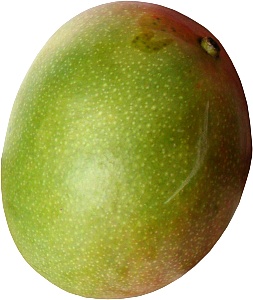 | The mango needed for this recipe doesn't have to be
particularly ripe - different but equally valid flavours. |
For this, you can use unripe mango - which is not very sweet but has a nice sharp tang to it - or ripe mango which has a nice but different flavour as well as a lot of sweetness (or, anywhere in between of course).
Skin the mango and put the pieces in the blender jug - remembering not to include the rather conspicuous seed.
Top and tail the onion, cutting it up so that nothing is bigger than around a 2cm cube and put around half of that into the blender's jug.
Add the freshly washed mint leaves to the jug.
Put the rest of the onion on top of the mint.
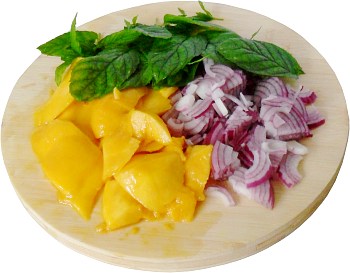 | Mango, mint and red onion, all ready
for blending into your chutney. |
Blend the contents of the blender jug as described in the Apple chutney recipe above.
If you have already made the apple chutney recipe above and you are making this one with ripe mango, you will find that it blends a lot easier and makes a chutney that is a lot smoother.
This is because the fibres in the mango interlock and make something that is like a gel, a lot easier than the apple, which tends to be just an interlocked suspension of bits in apple juice.
Taste the mango chutney you have made and if it tastes too much of onion and you have use ripe mango, you can add some lemon juice to take the edge off the onion - if you have used unripe mango, some of the acid in the mango will tend to do this for you so you won't need as much. You can leave it for a short while - 20 minutes or so - and see if the flavour modifies and then adjust it.
In addition, if the chutney is too sour, you can add some sugar /jaggery to make it sweeter although this shouldn't be an issue with ripe mango unless you have added lemon juice to it.
You can, of course, add anything you like but remember that simple tastes best.
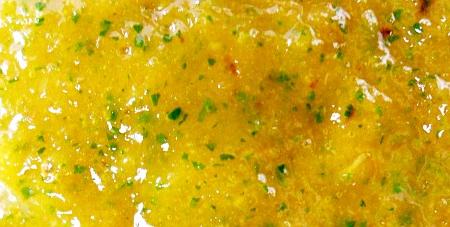 | Mango chutney. Dip your fresh parathas or samosas in this.
|
Variations:
Add anything that you like:
- Add some lemon juice to take the edge off the onion
- Add some sugar /jaggery to take the edge off the lemon juice or mango if it is particularly unripe
- A tiny pinch of kala namak - not enough to be able to recognise it as such.
Copyright
©2005 - 2021
P.A.Grosse. All Rights Reserved
|